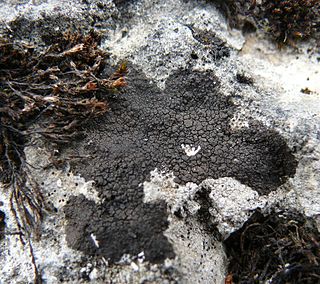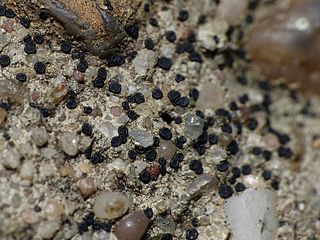
The Verrucariaceae are a family of mostly lichenised fungi in the order Verrucariales. The lichen-forming species, which comprise the vast majority of the family, have a wide variety of thallus forms, and include crustose (crust-like), foliose (bushy), and squamulose (scaly) representatives. Several characteristics of the spore-bearing structures, the ascomata, define the family, including their perithecioid form–more or less spherical or flask-shaped, with a single opening and otherwise completely enclosed by a wall. Squamulose members of the Verrucariaceae with simple ascospores, and without algae in the spore-bearing region are known as catapyrenioid lichens; there are more than 80 of these species. The family has several dozen lichenicolous (lichen-dwelling) examples, and a few genera that contain solely lichenicolous members. An unusually diverse variety of photobiont partners have been recorded, mostly green algae, but also brown algae and yellow-green algae.

Hydropunctaria is a genus of saxicolous (rock-dwelling), crustose lichens in the family Verrucariaceae. The genus includes both aquatic and amphibious species, with members that colonise either marine or freshwater habitats. The type species, Hydropunctaria maura, was formerly classified in the large genus Verrucaria. It is a widely distributed species common to littoral zones. Including the type species, five Hydropunctaria lichens are considered marine species: H. adriatica, H. amphibia, H. aractina, H. orae, and H. oceanica.
Xenonectriella nephromatis is a species of lichenicolous fungus in the family Nectriaceae. Found in Alaska, it was described as a species new to science in 2020 by Sergio Pérez-Ortega. The type specimen was discovered in the Hoonah–Angoon Census Area in Glacier Bay National Park, where it was growing on a Nephroma lichen. The specific epithet alludes to this host lichen.
Spilonema maritimum is a species of lichen in the family Coccocarpiaceae. Found in Alaska, it was described as a new species in 2020 by lichenologists Toby Spribille and Alan Fryday. The type specimen was collected in Juneau Borough, on the west side of Douglas Island. Here it was found growing on exposed seashore rocks roughly 2 m (6.6 ft) above the high tide line. Its specific epithet maritimum alludes to its close association with maritime rocks.
Porina rivalis is a species of semi-aquatic, saxicolous (rock-dwelling), and crustose lichen in the family Trichotheliaceae. Found in Great Britain, it was formally described as a new species in 2015 by lichenologist Alan Orange. The type specimen was collected in Nant Walch near Llanwrtyd Wells (Breconshire) at an altitude of 230 m (750 ft); here the lichen was found growing on stones submerged in a shaded stream. The species had been known previously from streams in Wales, but it had been incorrectly identified as Porina lectissima. Porina rivalis has also been recorded from streams in South-west England and North England. It has a thin brown thallus with prominent dark brown or black perithecia. Its ascospores are shaped like narrow ellipsoids, have three septa, and typically measure 13.0–17.5 by 4.0–5.5 μm.
Opegrapha vulpina is a species of lichenicolous (lichen-eating) fungus in the family Opegraphaceae. It is found in the Czech Republic, Dobruja, Romania, and the Italian Apennine Mountains. It grows parasitically on two species of saxicolous (rock-dwelling), crustose lichens.
Umbilicaria maculata is a species of saxicolous (rock-dwelling) umbilicate lichen in the family Umbilicariaceae. It is found in high-altitude alpine locations in Poland and France.
Caloplaca kedrovopadensis is a little-known species of crustose lichen in the family Teloschistaceae. It is only found in the Kedrovaya Pad Nature Reserve in the Russian Far East, and on the Jiri Mountain of South Korea. The lichen has been recorded growing on rocks and on bark.
Clypeococcum bisporum is a species of lichenicolous (lichen-eating) fungus in the family Polycoccaceae. It is found in the Russian Far East, in Mongolia, and from northwest Alaska, where it grows parasitically on lichens from the genera Cetraria and Flavocetraria.
Verrucaria vitikainenii is a species of saxicolous (rock-dwelling) crustose lichen in the family Verrucariaceae. It is found in Finland, where it occurs on calcareous rock outcrops.
Verrucaria oulankaensis is a rare species of saxicolous (rock-dwelling) crustose lichen in the family Verrucariaceae. It is found in north-eastern Finland, where it occurs on calcareous rocks on river shores.
Verrucaria ahtii is a species of saxicolous (rock-dwelling) crustose lichen in the family Verrucariaceae. It is found in Finland, Lithuania, Russia, and Switzerland, where it occurs on calcareous pebbles.
Psoroglaena stigonemoides is a species of corticolous (bark-dwelling) lichen in the family Verrucariaceae. It occurs in Great Britain and Ireland. It was first described scientifically by lichenologist Alan Orange in 1989, as Macentina stigonemoides. He collected the type specimen from Cardiganshire, Cambria, where it was found growing on the bark of Ulmus glabra in a humid forest. Aino Henssen transferred it to the genus Psoroglaena in 1995.

Verrucaria muralis is a species of saxicolous (rock-dwelling, crustose lichen in the family Verrucariaceae. It is a common species with an almost cosmopolitan distribution, occurring in an altitudinal range extending from the lowlands to the subalpine zone. It grows on calcareous rocks and walls. It was first formally described as a new species in 1803 by Swedish lichenologist Erik Acharius.
Verrucaria simplex is a species of saxicolous (rock-dwelling), crustose lichen in the family Verrucariaceae. Found in Europe and Asia, it was described as new to science in 1988 by lichenologist Patrick McCarthy. The type specimen was collected by Brian Coppins from Morpeth, Northumberland; there, it was found growing on a fragment of mortar-cement lying on the floor of a woodland. The lichen was later reported from the Czech Republic, and Korea.
Verrucaria nodosa is a species of saxicolous (rock-dwelling), crustose lichen in the family Verrucariaceae. Found in freshwater habitats in Wales, it was formally described as a new species in 2013 by lichenologist Alan Orange. The type specimen was collected by the author north-west of Llanuwchllyn, Merioneth, where it was found growing on an unshaded rock in a stream. The lichen has a grey-green to dark brown thallus with an uneven surface crust. Its ascomata are in the form of somewhat convex to hemispherical perithecia measuring 220–460 μm in diameter, with an inconspicuous or tiny ostiole. Ascospores are ellipsoid and colourless, lack any septa, and typically measure 20.5–22.2–24.0 by 90–97–105 μm. The species is known only from a few streams in Wales, where it grows on shaded or lightly shaded rocks. Associated lichen species include Ionaspis lacustris, Rhizocarpon lavatum, Porpidia hydrophila, Sporodictyon cruentum, and Trapelia coarctata, as well as the mosses Racomitrium aciculare and Scapania undulata.
Verrucaria rosula is a species of saxicolous (rock-dwelling), crustose lichen in the family Verrucariaceae. Found in freshwater habitats in Europe, it was formally described as a new species in 2013 by lichenologist Alan Orange. The type specimen was collected by the author from Cwm Dringarth, Brecon Beacons (Brecknockshire), where it was found growing on an unshaded rock in a flush. The lichen has a grey-green to brown thallus that is 40–200 μm thick. New thallus growth is initiated by tiny, roughly spherical or polyhedral granules that increase in size to eventually form somewhat circular, rosette-like patches; the species epithet rosula refers to this type of growth. Verrucaria rosula has been recorded in Wales, southwest England, Scotland, and France, where it occurs on damp siliceous rocks and stones near streams or on flushed ground. Lichens that associate with V. rosula include Ionaspis lacustris, Thelidium pluvium, Verrucaria cernaensis, V. hydrophila, V. sublobulata and V. margacea.
Verrucaria placida is a species of saxicolous (rock-dwelling), crustose lichen in the family Verrucariaceae. Found in freshwater habitats in Europe, it was formally described as a new species in 2013 by lichenologist Alan Orange. The type specimen was collected by the author south of the Moelvi river, where it was found in woodland, growing on a stone in a shaded stream. The species epithet placida, derived from the Latin word for "quiet" or "peaceful", refers to the "smooth, unbroken thallus and the characteristic but unstriking appearance of this lichen". Verrucaria placida has been recorded in Norway, southern Germany, and Wales, where it occurs in small streams and grows on shaded siliceous rocks and stones.
Verrucaria hydrophila is a species of saxicolous (rock-dwelling), crustose lichen in the family Verrucariaceae. Found in freshwater habitats in Europe, it was formally described as a new species in 2013 by lichenologist Alan Orange. The type specimen was collected by the author from Melindwr, Coed y Fron Wyllt, where it was found in a woodland growing on a shaded stone in a stream. The lichen has a thin, smooth, grey-green to brownish thallus that is somewhat translucent when wet. It is widespread in Europe and the British Isles, where it grows on rocks and stones in streams and seepages; the species epithet refers to its semi-aquatic habitat.


